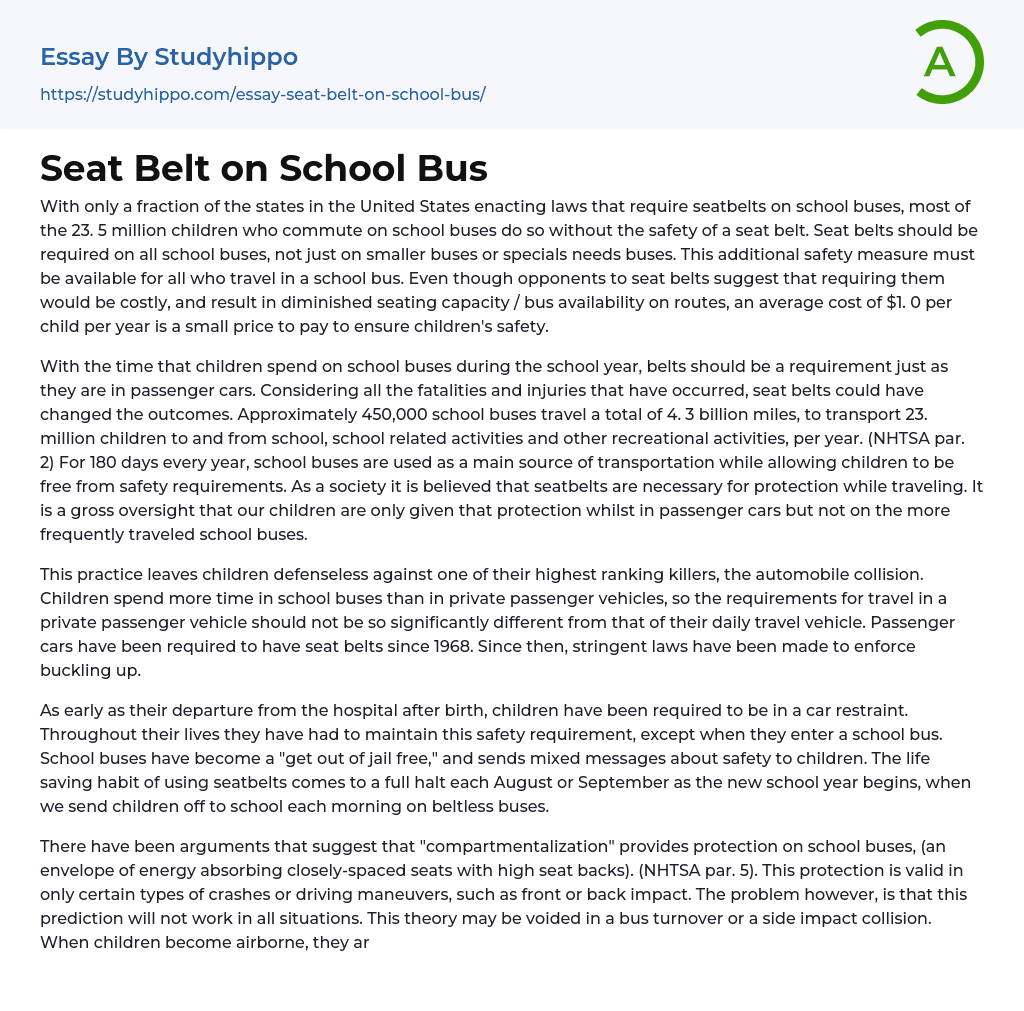With only a fraction of the states in the United States enacting laws that require seatbelts on school buses, most of the 23. 5 million children who commute on school buses do so without the safety of a seat belt. Seat belts should be required on all school buses, not just on smaller buses or specials needs buses. This additional safety measure must be available for all who travel in a school bus. Even though opponents to seat belts suggest that requiring them would be costly, and result in diminished seating capacity / bus availability on routes, an average cost of $1. 0 per child per year is a small price to pay to ensure children's safety.
With the time that children spend on school buses during the school year, belts should be a requirement just as they are in passenger cars. Co
...nsidering all the fatalities and injuries that have occurred, seat belts could have changed the outcomes. Approximately 450,000 school buses travel a total of 4. 3 billion miles, to transport 23. million children to and from school, school related activities and other recreational activities, per year. (NHTSA par. 2) For 180 days every year, school buses are used as a main source of transportation while allowing children to be free from safety requirements. As a society it is believed that seatbelts are necessary for protection while traveling. It is a gross oversight that our children are only given that protection whilst in passenger cars but not on the more frequently traveled school buses.
This practice leaves children defenseless against one of their highest ranking killers, the automobile collision. Childre
spend more time in school buses than in private passenger vehicles, so the requirements for travel in a private passenger vehicle should not be so significantly different from that of their daily travel vehicle. Passenger cars have been required to have seat belts since 1968. Since then, stringent laws have been made to enforce buckling up.
As early as their departure from the hospital after birth, children have been required to be in a car restraint. Throughout their lives they have had to maintain this safety requirement, except when they enter a school bus. School buses have become a "get out of jail free," and sends mixed messages about safety to children. The life saving habit of using seatbelts comes to a full halt each August or September as the new school year begins, when we send children off to school each morning on beltless buses.
There have been arguments that suggest that "compartmentalization" provides protection on school buses, (an envelope of energy absorbing closely-spaced seats with high seat backs). (NHTSA par. 5). This protection is valid in only certain types of crashes or driving maneuvers, such as front or back impact. The problem however, is that this prediction will not work in all situations. This theory may be voided in a bus turnover or a side impact collision. When children become airborne, they are no longer protected by this "compartmentalized" envelope.
The optimum protection that can be afforded to children on a school bus is a seat belt system, together with compartmentalization, to improve protection to young passengers during crashes. Both measures working as one will no doubt minimize injuries and
fatalities. According to the NHTSA (National Highway Traffic Safety Administration) school buses average approximately 26,000 crashes per year which result in 10 deaths. 25% of these deaths are drivers, and 75% are children (cong. rept. pg. 5 par. 7).
While the chances of children being a part of school bus accidents are low, the chances of injury or disability as a result of accidents with a traveling speeds greater than 35mph is too high. For children, the odds of surviving a school bus accident depend on five things; Age and size, being seated in an optimum location, being located perfectly in the seat, the compartmentalization of the bus, and how lucky they are. The fifth element shouldn't be luck; it should be "being buckled properly into a seat belt".
The American Academy of Pediatrics estimates that here were 51,100 school bus related injuries treated in U. S. emergency departments between 2001 and 2003. This represents an average of 17,000 injuries per year. (Ped. Vol. 118 pg. 2 par. 3 Results). Even though the injuries are based on estimation, a seat belt system on school buses can impact injury reduction in a Estimated number of school bus–related injuries treated in hospital EDs according month of treatment, United States, 2001–2003.
- Renault essays
- Truck essays
- chrysler essays
- The city essays
- Racing essays
- School Types essays
- Automobile essays
- Bus essays
- Civil engineering essays
- Cycling essays
- Electric Car essays
- Genetic Engineering essays
- Hybrid essays
- Innovation essays
- Internal Combustion Engine essays
- Invention essays
- Mechanical Engineering essays
- Mechanics essays
- Software Engineering essays
- Telephone essays
- Bicycle essays
- Cars essays
- Rms Titanic essays
- Code of Ethics essays
- Conflict essays
- Dress Code essays
- Human Resources essays
- Organizational Behavior essays
- Performance essays
- Recruitment essays
- Safety essays
- Classroom essays
- College essays
- E-Learning essays
- Elementary School essays
- Examination essays
- Graduate School essays
- High School essays
- History Of Education essays
- Homeschooling essays
- Kindergarten essays
- Middle School essays
- Public School essays
- School essays
- Single Sex Schools essays
- Special Education essays
- Student essays
- Teacher essays
- University essays
- Vocational Education essays




